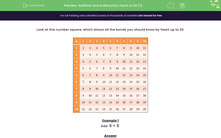In this activity, we will be answering simple addition and subtraction questions under 20.
We can answer these in our heads.
The most important thing is to take note of whether it is take away or add as little things like this can often lead to mistakes.
Here are some tips to help you:
Addition top tips
- Addition can happen in any order, so always start with the biggest number so that there is less to add on!
- Put the biggest number in your head and you can use your fingers to count on the rest of the numbers if that helps you.
- Use your number bond knowledge to help you where you can.
Subtraction top tips
- Subtraction number sentences can not be moved around, the biggest number must always go first!
- Subtraction means counting backwards.
- If the amount to take away is quite a big number, find the difference instead. This means counting up to find the difference between the two numbers we are given.
Let's look at some examples and how we could answer them, but remember that maths questions can be answered in all sorts of different ways, so don't be afraid to use a different technique - just check it works first!

Example 1
Add 6 + 9 =
Answer
So, let's put the biggest number first, which is 9, this means we have 6 left to add on.
We need to put 9 in our heads and count on 6 more (hold up 6 fingers if that helps!)
So after 9 it is 10, 11, 12, 13, 14, 15.
We've counted on 6 more numbers to 15, so
6 + 9 = 15
Example 2
Subtract 15 - 9 =
Answer
You could use find the difference here as 9 is quite a lot to take away.
To find the difference start on 9 and count up to 15. How many numbers did it take?
After 9: 10, 11, 12, 13, 14, 15
It was 6 more numbers so this is our answer!
15 - 9 = 6
Example 3
Add 12 + 5
Answer
You should know that 2 + 5 = 7,
so we need to add the 10 back onto the 2 and put a 10 onto the answer: 12 + 5 = 17
We have added the ones and then gone back to add the tens in.
How do you feel about all that? Are you ready for some questions?









